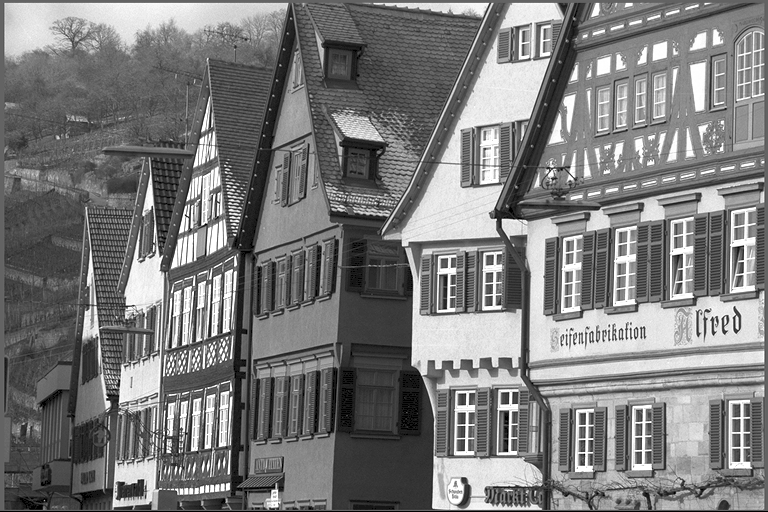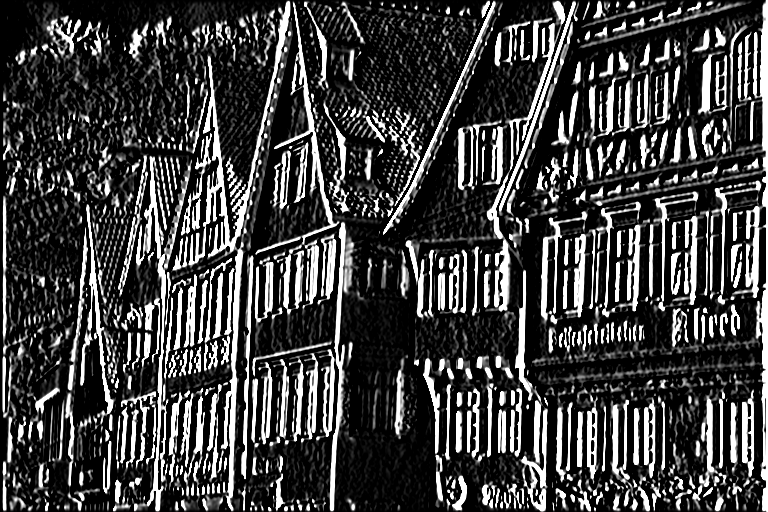Overview
The Separable Image Convolver algorithm performs a 2D convolution operation, but takes advantage of the fact that the 2D kernel is separable. The user passes one horizontal and one vertical 1D kernel. This usually leads to better performance, especially for kernels larger than 5x5. For smaller kernels, it's preferable to use Image Convolver algorithm with a 2D kernel directly.
| Input | Sobel kernel | Output |
|---|---|---|
 | \begin{eqnarray*} k_{col} &=& \frac{1}{64} \begin{bmatrix} 1 \\ 6 \\ 15 \\ 20 \\ 15 \\ 6 \\ 1 \end{bmatrix} \\ k_{row} &=& \begin{bmatrix} -1 & -5 & -6 & 0 & 6 & 5 & 1 \end{bmatrix} \end{eqnarray*} |  |
Implementation
Discrete 2D convolution is implemented using the following discrete function:
\begin{eqnarray*} I'[x,y] &=& \sum_{m=0}^{k_w} K_{row}[m] \times I[x,y-(m - \lfloor k_w/2 \rfloor)] \\ I''[x,y] &=& \sum_{m=0}^{k_h} K_{col}[m] \times I'[x-(m - \lfloor k_h/2 \rfloor),y] \end{eqnarray*}
Where:
- \(I\) is the input image.
- \(I'\) is the temporary image with convolution along the rows.
- \(I''\) is the final result.
- \(K_{row}\) is the row convolution kernel.
- \(K_{col}\) is the column convolution kernel.
- \(k_w,k_h\) are the kernel's width and height, respectively.
- Note
- Most computer vision libraries expect the kernel to be reversed before calling their convolution functions. Not so with VPI, we implement a actual convolution, not cross-correlation. Naturally, this is irrelevant if the kernel is symmetric.
Usage
- Initialization phase
- Include the header that defines the needed functions and structures. #include <vpi/algo/SeparableImageConvolver.h>
- Define the stream on which the algorithm will be executed, the input and output images.
- Create the output image. uint32_t w, h;vpiImageGetSize(input, &w, &h);VPIImageType type;vpiImageGetType(input, &type);VPIImage output;vpiImageCreate(w, h, type, 0, &output);
- Include the header that defines the needed functions and structures.
- Processing phase
- Define the kernel to be used. In this case, a simple 3x3 edge detector. float sobel_row[7] = {-1, -5, -6, 0, +6, +5, +1};float sobel_col[7] = {1 / 64.f, 6 / 64.f, 15 / 64.f, 20 / 64.f, 15 / 64.f, 6 / 64.f, 1 / 64.f};
- Submit the algorithm to the stream, passing the kernel, input, output images and boundary condition. VPI_CHECK_STATUS(vpiSubmitSeparableImageConvolver(stream, input, output, sobel_row, 7, sobel_col, 7, VPI_BOUNDARY_COND_ZERO));
- Optionally, wait until the processing is done. vpiStreamSync(stream);
- Define the kernel to be used. In this case, a simple 3x3 edge detector.
Consult the Image Convolution for a complete example.
Limitations and Constraints
Constraints for specific backends supersede the ones specified for all backends.
All Backends
- Input and output images must have the same dimensions and type.
- The following image types are accepted:
- Minimum 1D convolution kernel size is 1, maximum is 11.
- The following boundary conditions are accepted.
PVA
- Input and output dimensions must be between 160x92 and 3264x2448.
- Minimum 1D convolution kernel size is 2, maximum is 11.
- Horizontal and vertical kernel sizes must be equal, i.e., only square kernels can be used.
- Kernel weights are restricted to \(|weight| < 1\).
- The following image types are accepted:
- The following boundary conditions are accepted.
Performance
For further information on how performance benchmarked, see Performance Measurement.
| size | type | kernel | CPU | CUDA | PVA |
|---|---|---|---|---|---|
| 1920x1080 | u8 | 3x3 | 0.668 ms | 0.0649 ms | n/a |
| 1920x1080 | u8 | 5x5 | 0.831 ms | 0.0688 ms | n/a |
| 1920x1080 | u8 | 7x7 | 1.00 ms | 0.0878 ms | n/a |
| 1920x1080 | u8 | 11x11 | 1.290 ms | 0.0994 ms | n/a |
| 1920x1080 | s16 | 3x3 | 0.452 ms | 0.1069 ms | 3.1794 ms |
| 1920x1080 | s16 | 5x5 | 0.58 ms | 0.1153 ms | 3.8299 ms |
| 1920x1080 | s16 | 7x7 | 1.119 ms | 0.1348 ms | 3.7808 ms |
| 1920x1080 | s16 | 11x11 | 1.30 ms | 0.1596 ms | 4.7061 ms |
| size | type | kernel | CPU | CUDA | PVA |
|---|---|---|---|---|---|
| 1920x1080 | u8 | 3x3 | 1.39 ms | 0.258 ms | n/a |
| 1920x1080 | u8 | 5x5 | 1.82 ms | 0.288 ms | n/a |
| 1920x1080 | u8 | 7x7 | 2.19 ms | 0.397 ms | n/a |
| 1920x1080 | u8 | 11x11 | 3.00 ms | 0.473 ms | n/a |
| 1920x1080 | s16 | 3x3 | 1.83 ms | 0.383 ms | n/a |
| 1920x1080 | s16 | 5x5 | 2.05 ms | 0.422 ms | n/a |
| 1920x1080 | s16 | 7x7 | 2.58 ms | 0.585 ms | n/a |
| 1920x1080 | s16 | 11x11 | 3.47 ms | 0.686 ms | n/a |
| size | type | kernel | CPU | CUDA | PVA |
|---|---|---|---|---|---|
| 1920x1080 | u8 | 3x3 | 3.14 ms | 0.670 ms | n/a |
| 1920x1080 | u8 | 5x5 | 3.80 ms | 0.7460 ms | n/a |
| 1920x1080 | u8 | 7x7 | 4.84 ms | 1.027 ms | n/a |
| 1920x1080 | u8 | 11x11 | 6.80 ms | 1.235 ms | n/a |
| 1920x1080 | s16 | 3x3 | 3.540 ms | 0.985 ms | n/a |
| 1920x1080 | s16 | 5x5 | 4.24 ms | 1.050 ms | n/a |
| 1920x1080 | s16 | 7x7 | 5.38 ms | 1.424 ms | n/a |
| 1920x1080 | s16 | 11x11 | 7.32 ms | 1.693 ms | n/a |